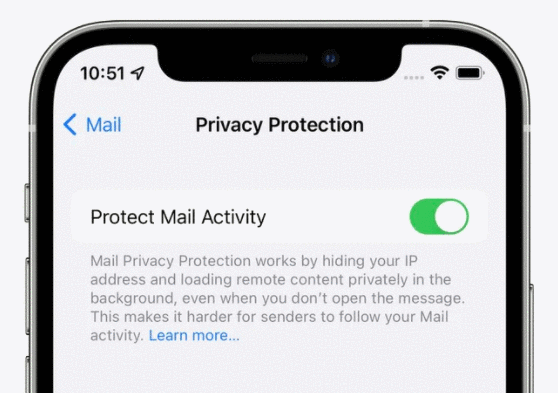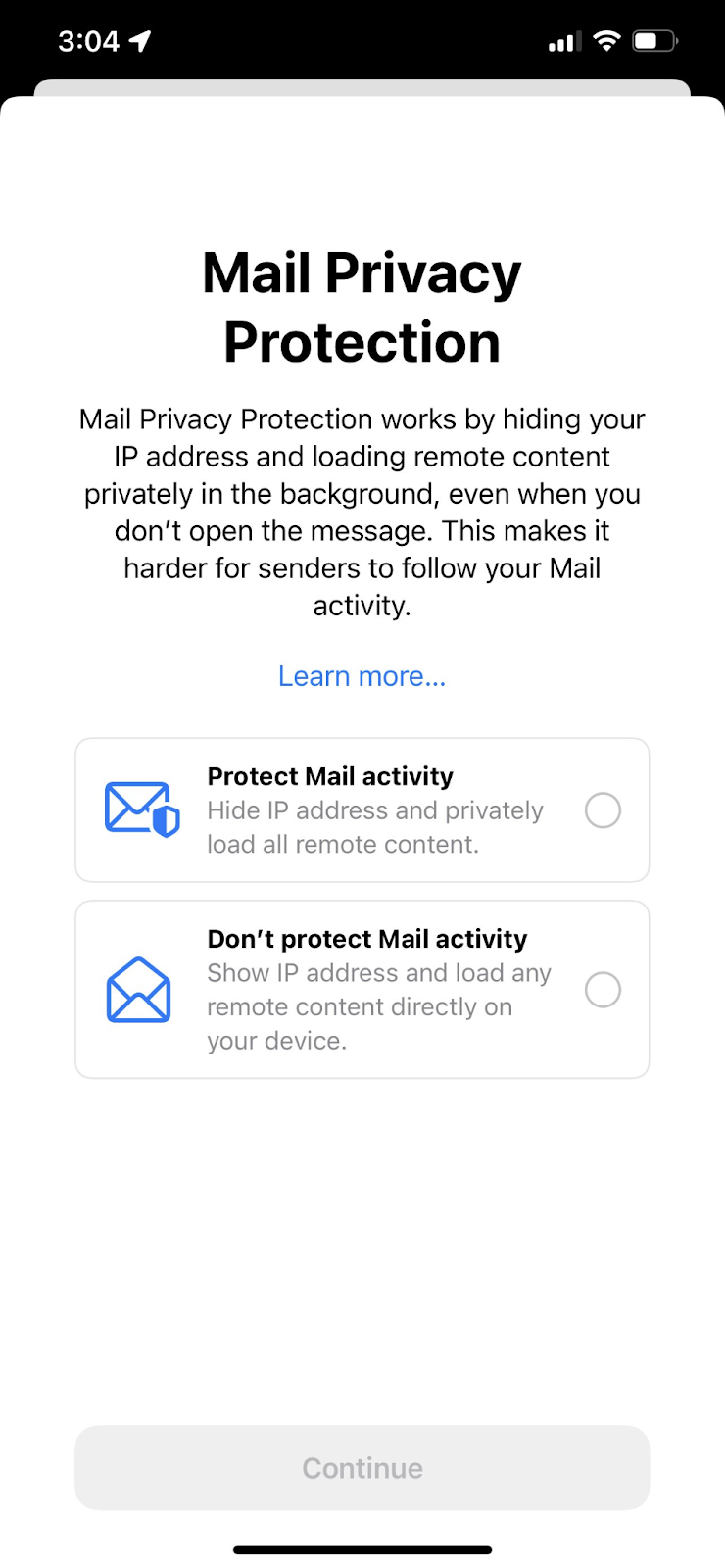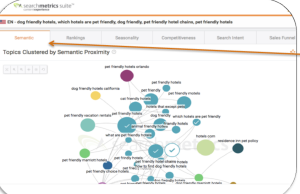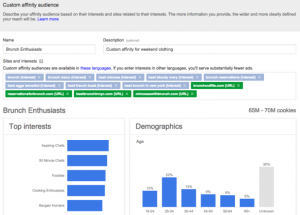You might have heard about Apple’s upcoming Mail Privacy changes and how they’ll impact email marketing. Perhaps you’ve heard people saying, “The email open rate is dead!” or that Apple Mail Privacy will forever change the landscape of email marketing. And now you’re looking to see what all the fuss is about.
Well, first of all, two pieces of good news:
- You’ve come to the right place
- Fundamentally, nothing is changing about what makes email the most effective form of marketing
Hopefully, I’ve at least set your mind at ease a little. The truth is, there’s no need to worry. But there are some changes coming to the world of email marketing as a result of Apple’s Privacy updates for iOS 15 and their popular Mail app that you should be aware of. These changes aren’t specific to any email marketing provider and will impact you no matter which platform you’re using, so it’s worth taking some time to get familiar with them.
Read on for a breakdown of Apple’s upcoming privacy changes, how Mail Privacy Protection affects email marketing, what’s not changing about email, and some simple steps you can take to make sure your emails continue to drive valuable results.
Table of Contents
- What is Apple’s Mail Privacy Protection?
- Why Mail Privacy Protection matters for email marketing
- When does Mail Privacy Protection go into effect?
- How many people on my email list will use Mail Privacy Protection?
- 5 Ways Mail Privacy Protection impacts email marketing
- 4 steps to take to ensure effective email marketing in the age of Mail Privacy Protection
- Let us help you drive results through email marketing, even with Apple’s privacy changes
What is Apple’s Mail Privacy Protection?
The short answer is that Mail Privacy Protection will give users of Apple’s Mail app the option of hiding if and when they open marketing emails.
Here’s the full story:
Mail Privacy Protection is an upcoming Apple Mail feature announced in June of 2021 that will prevent email marketers from using invisible pixels to collect information from recipients. The feature will be available for users of Apple’s Mail app for iPhone, iPad, Mac computers, and Apple Watch, allowing them to mask information such as when and where they open an email, what device they used, and any other online activity linked to that device.
In the past, data from an email was loaded only when the recipient opened the email and downloaded the email’s images, which happened automatically in most cases. This data included a pixel, which allowed your email provider to detect that the email was opened, what device was used, and sometimes where the subscriber was located when they opened the email. With Mail Privacy Protection, Apple Mail will preload images and content of emails you send — including the tracking pixel — regardless of if the recipient actually opened the email or not.
This makes data from these pixels unreliable as a performance metric.

Apple’s iOS 15 update will allow users to protect their mail activity by hiding their IP address and loading content privately
Why Mail Privacy Protection matters for email marketing
Apple Mail is an extremely popular email client
Apple Mail is one of the most popular email clients in use today, largely because it’s the default email application for users of all Apple devices. In 2021, Apple devices accounted for approximately 52 percent of all email opens, according to Litmus.
Mail Privacy Protection will likely be offered as an option to all Apple Mail users shortly after the feature becomes available. It’s still unclear how many users will opt-in to this feature, but people using email marketing tools should be prepared to rely less on email open data. Generally, when users are given the opportunity to opt-out of data tracking, they take it. We expect these new privacy features to be as popular as previously released iOS features, like opting out of app data tracking.

A screenshot shared from the iOS 15 beta indicates that Mail Privacy Protection will be offered prominently to Apple Mail users on their first open of the app after the feature is released.
Email data will be limited, and therefore so will some of the features powered by that data
Besides not knowing if, when, and how a subscriber opened your email, certain email marketing features that rely on this data, such as auto-sending a follow-up email to non-openers, will no longer be as reliable. Read on for more info about how this will affect email marketing and some steps you can take to ensure you’re marketing effectively.
When does Mail Privacy Protection go into effect?
Mail Privacy Protection is expected to roll in the fall of 2021 on all Apple devices alongside the release of iOS 15. While Apple hasn’t announced a specific iOS 15 release date yet, the beta test is already available to some users. We’ll update this article when an official release date for iOS 15 is announced. For now, the release is rumored to take place between September and November of 2021.
How many people on my email list will use Mail Privacy Protection?
While no two email lists are exactly the same, let’s make an educated guess of how many contacts may use Apple’s newest privacy features.
Assuming 52 percent of your list is using an Apple email client to read your emails (based on the average for all email opens in 2021), and that 96% of them will opt-in to additional privacy protection (as was the case with the app tracking feature for iOS 14.5), we’ll estimate that about 50 percent of your subscribers will likely use Mail Privacy Protection once it becomes available.
5 Ways Mail Privacy Protection impacts email marketing
While not much is changing in terms of how to use email marketing successfully, there are some things you should be aware of. It’s important to note that these changes aren’t specific to any email marketing provider, but will impact the world of email as a whole, no matter what platform you’re using for your email marketing.
Below, we’ve listed some of the top changes resulting from Apple’s new privacy features that you should be aware of. Then in the next section, we’ll go over some specific steps you can take to maximize your email marketing success, even with the new privacy changes.
Here’s what’s changing in the world of email marketing as a result of Apple’s privacy updates:
1. Open rates will likely increase but are no longer reliable
Since Apple will begin pre-loading email data regardless of whether a user actually opened an email, email open rates will become unreliable. You might see your email open rates skyrocket as a result of these changes, but those won’t be actual email opens.
2. Click-to-open rates will likely decrease but are also unreliable
A click-to-open rate (CTOR) is the number of unique clicks your email receives divided by the number of unique opens. In the past, this was a favored metric for email marketers to measure how effective their content was at motivating their audience to click. However, since CTOR is a function of your email opens, Apple’s new privacy changes will cause your CTOR to plummet downwards artificially. That makes CTOR a relatively unreliable metric going forward.
But there is some good news! Mail Privacy Protection will not have an impact on your total clicks. Clicks remains a reliable way to measure the success of your email because it simply shows the total number of email recipients who clicked a link in your email. Comparing total clicks across email campaigns with a similar number of recipients is a good way to assess which campaigns are most engaging.
3. Open rate-powered email features will become less reliable
Some email marketing features that rely on email opens and other pixel data will become less reliable, as that data might not be available from half of email recipients.
Here’s how some popular email marketing features will be impacted:
Contact insights and engagement
When viewing your contact insights and email reporting, since open rates could be artificially high for about half of your subscribers, you’ll likely see an unusually large number of contacts with high engagement, as contact engagement has typically been based on how often a contact opens your emails.
Email list segmentation
Some email marketers use email open data to segment email lists into “most engaged” or “least engaged” subscribers, based on how often they open emails. Since open rates are becoming unreliable, they are no longer an effective way to determine who your most engaged subscribers are for list segmentation.
Luckily, other forms of email segmentation that don’t rely on open data — like click segmentation or manually created segments — won’t be impacted by Apple’s privacy changes and are still useful.
Resend to non-openers
This feature normally allows you to automatically resend an email to anyone who hasn’t opened it after a specified period of time. Since your subscribers who use Apple Mail will now show as having opened every email, those people will no longer receive the automatic resend.
Automated email series
Some automated email series are set up to trigger based on if and when a subscriber opens a previous email. This is no longer an effective way to set up your email series since Apple Mail will report an artificial open for some of your subscribers and trigger the next email, whether someone read your previous email or not. Instead, consider using an email click as a trigger in your automated email series (more on that and other recommendations in the next section).
It’s worth noting that many automated emails won’t be affected by this change. For example, automated welcome email series are often set up to send each email after a specific number of days, using time-based triggers rather than open-based triggers. Those automated series will continue to function as before.
A/B subject line testing
A/B subject line testing typically involves sending out two versions of your email with two different subject lines to a small portion of your email list. Then, the subject line that generates a higher open rate is chosen as the winner and the rest of your list receives an email with the winning open rate automatically. Unreliable open rates make the results of A/B testing for subject lines generally unreliable.
4. Individual user data (like location, time opened, etc.) from Apple Mail users will no longer be available to email marketers
Since Apple is working to protect Apple Mail users’ individualized data as they beef up their Intelligent Tracking Prevention, it’s likely that marketers will have access to less and less information about an individual subscriber’s online activity.
Here’s some of the individualized subscriber data we expect to become less accessible for all marketers:
- Time an email was opened
- Device used to open an email
- Location from which an email was opened
5. Personalization isn’t going away, but it’s changing a little
Most forms of email personalization — like including names in email subject lines, or personalizing content based on what a subscriber has clicked on — will remain unaffected. The types of personalization you’ll need to be careful about are based on — you guessed it — email opens.
As I previously mentioned, personalizing by creating segments for “most engaged subscribers” based on how often they open your emails is no longer recommended. Instead, you’ll want to identify your most- and least-engaged subscribers by how often they click links within your emails.
What’s not changing about email marketing
More good news: Email still has the highest return on investment (ROI) of all forms of marketing and is even more likely to drive sales than other channels like social media marketing.
And many of our recommended email marketing best practices stay the same. When it comes to email marketing, your focus is still on driving real results, like increasing sales, reaching new customers, and engaging existing customers. The ultimate goal has never been to get the highest possible open rate.
That said, there are some things you should check up on to make sure you’re getting the best possible results from your email marketing. Read on for some things you can do now to secure your success in the future.
4 steps to take to ensure effective email marketing in the age of Mail Privacy Protection
If you’re already optimizing your email marketing to drive real results, fortunately, there aren’t many changes you need to make to your email marketing plan. However, this is a good time to do a quick checkup and ensure you’re using the most effective email marketing tactics that will work for you regardless of the coming changes to email privacy.
Here are five things you can do to ensure success with email marketing now and in the future.
1. Reconsider the way you measure the success of your email marketing
It’s important to reflect on the way you measure email marketing success — namely, going beyond just opens and clicks. Even though email clicks are still reliable, they shouldn’t be the end-all-be-all metric you go to when determining if your efforts have been successful. After all, it’s unlikely that your primary business goal is getting a bunch of people to click a link in your email.
Luckily, savvy small businesses are already measuring success with more valuable metrics than open rate. According to a Constant Contact survey of 1,000 small businesses, open rate isn’t a top-five metric for evaluating the success of their email marketing campaigns. Instead, small businesses are focused on these top five metrics:
- Conversion Rate – The percentage of email recipients who take a specific action, like making a purchase
- List Growth Rate – How fast you’re adding new email subscribers versus losing people clicking “unsubscribe”
- Overall ROI – The amount of revenue you generate for every dollar you invest in email marketing
- Click Rate – The percentage of your email recipients who click a link in your email
- Forwarding/Email Sharing – How often your subscribers forward and share your emails with their own contacts, expanding the reach of your email campaign
Think about your business goals and how you’re using email marketing to reach them. Then, make sure that the metrics you’re paying the most attention to map directly to those goals.
2. For automation, use clicks and time-based triggers rather than open-based triggers
For any automated emails or email drip campaigns you have set up, make sure you’re avoiding triggers related to opens. Instead, use the following as triggers for email automation:
- Clicks on a particular link or piece of content
- Time-based triggers (send email two X days after email one)
- Date-based triggers, like birthday and anniversary emails
- Ecommerce behavior triggers, like abandoned cart emails
3. Familiarize yourself with best practices that get more people to open your emails
While you’ll have less clear visibility into how many people are opening your emails, it’s still super important that your emails are opened! After all, how will you engage subscribers and get them to take valuable action if they don’t read your emails in the first place?
So make sure to familiarize yourself with our tips for how to create good email subject lines. But remember, subject lines aren’t the only thing your subscribers see in their inbox.
You’ll also want to pay attention to your email’s “from” name — make sure it’s something that your subscribers will recognize and trust. You’ll also want to customize your email’s preheader — this is the text that shows up in the preview of your email in many popular email clients.

In the email subject line example above, the subject line is the bold text that says “John, it’s your time to start roller skating!”, the from name is “RINK Skate Center” and the preheader is the gray text that says “Get a discount on skating lessons when you enroll before May 1st.”
4. Anticipate more changes — knowing that we’ll be here to support you!
These privacy changes to Apple Mail are almost certainly not the last, and it’s likely that other tech companies could follow Apple’s lead in further protecting consumer data. It’s best to embrace this change now as an opportunity to assess what matters most to you when it comes to email marketing, and to focus on those goals.
Digital & Social Articles on Business 2 Community
(157)
Report Post






